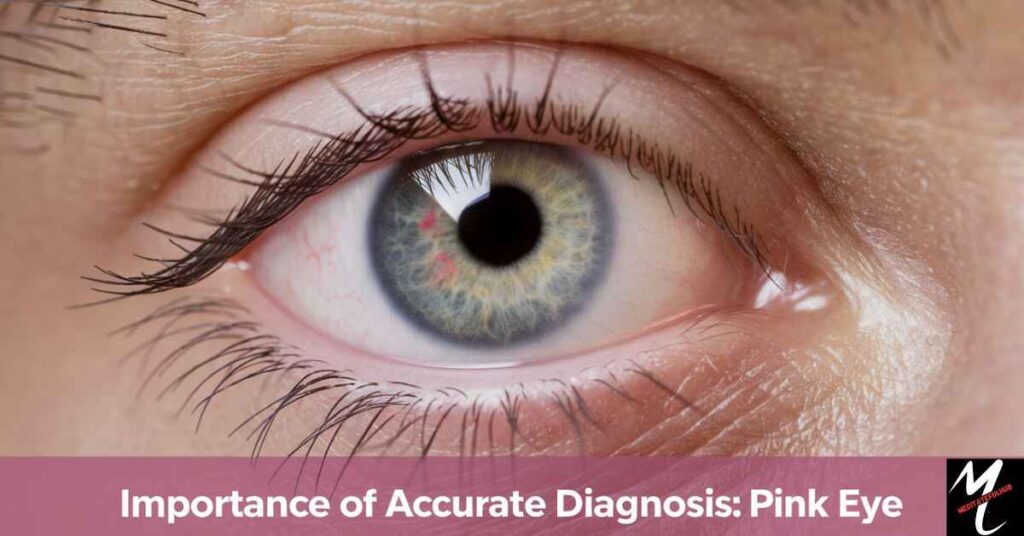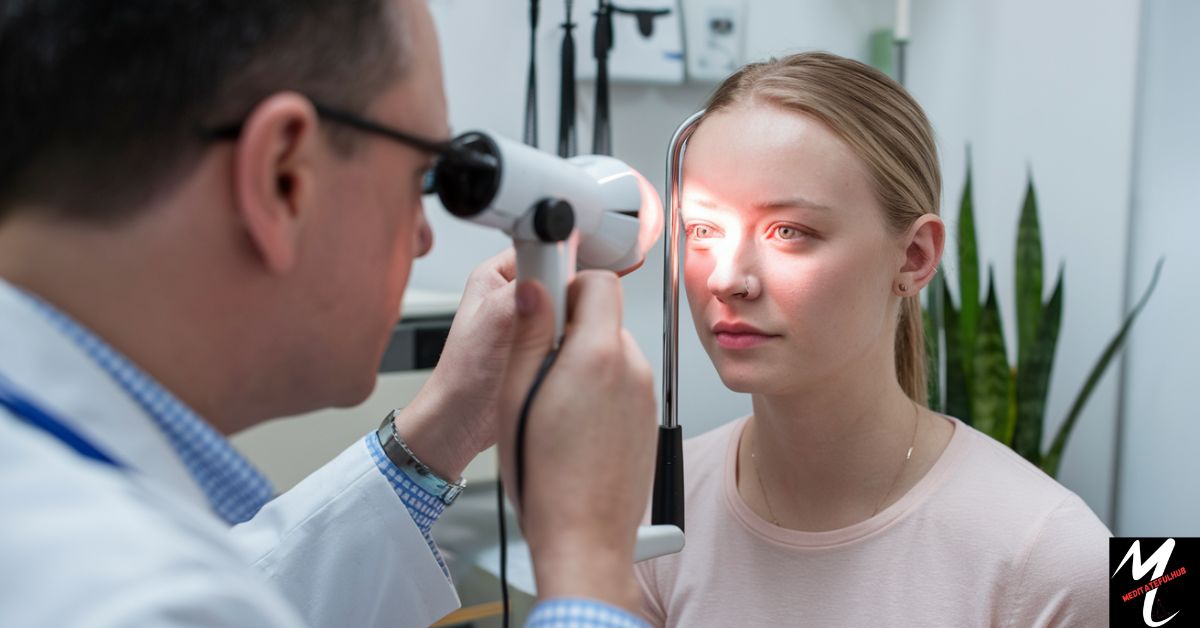As a parent, seeing your toddler’s eyes turn red and irritated can be alarming. Your first thought might be pink eye, a common eye infection in young children. However, not all red eyes are caused by pink eye.
Many conditions can mimic its symptoms, leading to misdiagnosis and improper treatment. This comprehensive guide will help you understand what is commonly misdiagnosed as pink eye in toddlers and how to identify various eye conditions accurately.
Understanding Pink Eye in Toddlers
Pink eye, medically known as conjunctivitis, is an inflammation of the conjunctiva, the thin membrane covering the white part of the eye and the inner surface of the eyelid. It’s a common condition affecting millions of people each year, with toddlers being particularly susceptible due to their developing immune systems and close contact with other children.
The term “pink eye” can be misleading, as it encompasses various types of conjunctivitis, each with distinct causes and treatments. Understanding these differences is crucial for proper diagnosis and management of eye conditions in toddlers.
What Causes Pink Eye in Toddlers?
Pink eye in toddlers can result from several factors. The most common causes are viral conjunctivitis, bacterial conjunctivitis, and allergic conjunctivitis. Viral conjunctivitis is often associated with common cold viruses and is highly contagious. Bacterial conjunctivitis, on the other hand, is caused by bacteria and can spread quickly in daycare settings. Allergic conjunctivitis occurs when the eyes react to allergens like pollen, pet dander, or dust mites.
Environmental factors can also play a role in causing eye irritation that mimics pink eye. Exposure to chlorine in swimming pools, smoke, or other irritants can cause redness and discomfort similar to conjunctivitis. It’s essential to consider these factors when assessing your toddler’s eye symptoms.
Common Symptoms of Pink Eye in Toddlers
Recognizing the symptoms of pink eye in toddlers is crucial for early intervention. The most noticeable sign is red eyes, often accompanied by itching, eye irritation, and a feeling of grittiness. Toddlers with pink eye may rub their eyes frequently and complain of discomfort. Eye discharge is another common symptom, which can vary depending on the type of conjunctivitis.
In viral conjunctivitis, the discharge is typically watery, while bacterial conjunctivitis often produces a thicker, yellowish-green discharge that can cause the eyelids to stick together, especially after sleep. Allergic conjunctivitis usually presents with watery eyes and itching. It’s important to note that these symptoms can overlap, making accurate diagnosis challenging without professional evaluation.
Conditions Often Mistaken for Pink Eye in Toddlers
While pink eye is common in toddlers, several other conditions can present similar symptoms, leading to misdiagnosis. Understanding these look-alike conditions is crucial for proper eye health management in young children.
Eye Allergies in Toddlers
Eye allergies, or allergic conjunctivitis, can easily be mistaken for infectious pink eye. Both conditions cause redness, itching, and watering of the eyes. However, eye allergies are not contagious and are often accompanied by other allergy symptoms like sneezing or a runny nose. Allergic reactions in the eyes are typically triggered by environmental factors such as pollen, pet dander, or dust mites.
Differentiating between eye allergies and infectious pink eye is crucial for appropriate treatment. While pink eye may require antibiotics in some cases, eye allergies are typically managed with antihistamines or other allergy medications. Misdiagnosing eye allergies as pink eye can lead to unnecessary antibiotic use, contributing to antibiotic resistance.
Dry Eye Syndrome in Young Children
Dry eye syndrome is another condition that can mimic the symptoms of pink eye in toddlers. While less common in young children than in adults, it can occur due to various factors, including environmental conditions, certain medications, or underlying health issues. Dry eye syndrome causes redness, irritation, and a gritty feeling in the eyes, similar to pink eye.
The key difference is that dry eye syndrome doesn’t cause the thick discharge typically associated with bacterial conjunctivitis. Instead, children with dry eyes may experience excessive tearing as the eyes attempt to compensate for the lack of moisture. Treatment for dry eye syndrome often involves lubricating eye drops and addressing any underlying causes, rather than the antibiotics used for bacterial pink eye.
Blepharitis in Toddlers
Blepharitis, an inflammation of the eyelids, can also be mistaken for pink eye in toddlers. This condition causes redness, irritation, and sometimes a crusty buildup along the eyelashes. While these symptoms are similar to those of pink eye, blepharitis is typically chronic and requires different management strategies.
Unlike pink eye, which often resolves within a week or two, blepharitis is a long-term condition that requires ongoing eye care. Treatment usually involves regular eyelid hygiene, warm compresses, and in some cases, prescription medications. Misdiagnosing blepharitis as pink eye can lead to ineffective treatment and prolonged discomfort for the child.
Foreign Body in a Toddler’s Eye
Sometimes, what appears to be pink eye might actually be irritation caused by a foreign body in the eye. Toddlers are curious and often touch their eyes with dirty hands or rub their eyes when something irritates them. This can introduce small particles like sand, dirt, or even a tiny eyelash into the eye, causing redness and discomfort.
Unlike pink eye, which affects both eyes in most cases, irritation from a foreign body is usually limited to one eye. The discomfort typically comes on suddenly and may be accompanied by excessive tearing as the eye tries to flush out the irritant. If you suspect a foreign body in your toddler’s eye, it’s essential to seek immediate medical attention to prevent potential damage to the eye.
Viral vs. Bacterial Conjunctivitis in Toddlers

Understanding the difference between viral conjunctivitis and bacterial conjunctivitis is crucial for proper treatment of pink eye in toddlers. While both types cause redness and discomfort, there are key differences in their presentation and management.
Viral Conjunctivitis in Toddlers
Viral conjunctivitis is the most common form of pink eye in toddlers. It’s highly contagious and often associated with upper respiratory infections. Symptoms typically start in one eye and may spread to the other within days. The discharge is usually watery, and the eyes may be itchy and feel gritty.
Treatment for viral conjunctivitis is primarily supportive, focusing on relieving symptoms. Antibiotics are not effective against viruses, so they’re not prescribed for this type of pink eye. Instead, management includes keeping the eyes clean, using cold compresses to reduce discomfort, and letting the infection run its course, which typically takes 1-2 weeks.
Bacterial Conjunctivitis in Toddlers
Bacterial conjunctivitis is less common but often more severe than viral conjunctivitis. It’s characterized by redness, swelling, and a thick, yellowish-green discharge that can cause the eyelids to stick together, especially after sleep. Both eyes are usually affected, although one eye may show symptoms before the other.
Unlike viral conjunctivitis, bacterial pink eye is typically treated with antibiotic eye drops or ointments. It’s important to complete the full course of antibiotics as prescribed, even if symptoms improve quickly. Proper hand hygiene and avoiding sharing towels or washcloths are crucial to prevent the spread of bacterial conjunctivitis.
Non-Infectious Conjunctivitis in Toddlers
Not all cases of conjunctivitis are caused by infections. Non-infectious conjunctivitis can result from various factors, including irritants, allergens, or underlying health conditions. Understanding these non-infectious causes is essential for accurate diagnosis and appropriate management of eye conditions in toddlers.
Chemical Conjunctivitis in Toddlers
Chemical conjunctivitis occurs when the eyes are exposed to irritants or harmful substances. In toddlers, this can happen from chlorine in swimming pools, soap getting into the eyes during bath time, or exposure to household cleaning products. The symptoms can closely resemble infectious pink eye, with redness, tearing, and discomfort.
Treatment for chemical conjunctivitis involves removing the irritant and rinsing the eyes thoroughly with clean water. In most cases, the symptoms resolve quickly once the irritant is removed. However, if symptoms persist or if you suspect exposure to a harmful chemical, it’s crucial to seek immediate medical attention to prevent potential damage to the eye.
Allergic Conjunctivitis in Toddlers
Allergic conjunctivitis is a common cause of eye irritation in toddlers, especially during allergy seasons. It occurs when the eyes react to allergens like pollen, pet dander, or dust mites. The symptoms can be similar to infectious pink eye, including redness, itching, and watery discharge.
Unlike infectious conjunctivitis, allergic conjunctivitis is not contagious and often occurs alongside other allergy symptoms like sneezing or a runny nose. Treatment typically involves avoiding the allergen when possible and using antihistamine eye drops or oral allergy medications as recommended by a healthcare provider. In some cases, identifying and managing environmental triggers can help prevent recurrent episodes of allergic conjunctivitis.
Importance of Accurate Diagnosis

Accurate diagnosis of eye conditions in toddlers is crucial for several reasons. Misdiagnosis can lead to inappropriate treatment, delayed resolution of symptoms, and potential complications. Understanding the importance of proper diagnosis can help parents make informed decisions about their child’s eye health.
Risks of Misdiagnosis
Misdiagnosing eye conditions in toddlers can have several negative consequences. For instance, treating viral conjunctivitis with antibiotics not only fails to address the underlying cause but also contributes to antibiotic resistance. Conversely, failing to treat bacterial conjunctivitis with appropriate antibiotics can lead to prolonged infection and potential complications.
Misdiagnosis can also result in unnecessary medication use, which may cause side effects or allergic reactions in some children. Additionally, failing to identify non-infectious causes of eye irritation, such as allergies or dry eye syndrome, can lead to recurrent symptoms and unnecessary discomfort for the child.
When to Seek Professional Help
Given the potential risks of misdiagnosis, it’s important to know when to seek professional help for your toddler’s eye symptoms. As a general rule, any persistent eye symptoms that don’t improve within 24-48 hours warrant a visit to an eye doctor or pediatrician. Additionally, seek immediate medical attention if your toddler experiences severe eye pain, vision changes, or if you suspect exposure to a harmful substance.
An eye doctor can perform a thorough examination to determine the cause of your toddler’s eye symptoms and recommend appropriate treatment options. They can also provide guidance on preventing future eye infections and maintaining overall eye health in young children.
Read This Blog: What Happens If You Use Out of Date Eye Drops: A Comprehensive Guide
Prevention and Management of Eye Conditions in Toddlers
Preventing eye conditions in toddlers involves a combination of good hygiene practices and awareness of potential risk factors. While it’s not always possible to prevent every eye infection or irritation, there are steps parents can take to reduce the likelihood of their toddler developing eye problems.
Hygiene Practices for Toddler Eye Health
Good hygiene is crucial in preventing the spread of infectious eye conditions. Teach your toddler to wash their hands frequently, especially before touching their eyes. Avoid sharing towels, washcloths, or other personal items that come into contact with the face. If your child wears glasses, clean them regularly to remove potential irritants.
For toddlers prone to eye allergies, regular cleaning of bedding and stuffed animals can help reduce exposure to allergens. Using hypoallergenic products and keeping indoor air clean with air purifiers can also help manage allergic eye symptoms.
Environmental Factors Affecting Toddler Eye Health
Be aware of environmental triggers that can affect your toddler’s eye health. Protect their eyes from harsh sunlight with sunglasses or a hat. In dusty or windy conditions, consider using wrap-around sunglasses to shield their eyes from irritants. If your toddler swims, use goggles to protect their eyes from chlorine and other pool chemicals.
Indoor air quality is also important. Reduce exposure to smoke, strong cleaning products, and other potential irritants. If you live in an area with high pollen counts, consider keeping windows closed during peak allergy seasons and using air conditioning with a good filter to reduce indoor allergens.
Also Read: Does Character AI Allow NSFW Content?
Diagnosis Methods for Toddler Eye Conditions
Proper diagnosis of eye conditions in toddlers often requires professional evaluation. Eye doctors and pediatricians use various methods to determine the cause of eye symptoms and recommend appropriate treatment.
Physical Examination Techniques
A thorough eye examination is the first step in diagnosing eye conditions in toddlers. The doctor will examine the eyes’ appearance, checking for redness, swelling, or discharge. They may use a special magnifying device called a slit lamp to get a closer look at the eye’s structures.
The doctor will also assess the child’s vision and eye movements. For toddlers who can’t read an eye chart, there are special tests designed to evaluate vision in young children. The doctor may also check for signs of other health conditions that could be affecting the eyes.
Laboratory Tests for Eye Infections
In some cases, laboratory tests may be necessary to confirm the diagnosis of an eye infection. The doctor may take a sample of eye discharge to test for specific bacteria or viruses. This can help determine whether the infection is bacterial or viral, guiding the choice of treatment.
For suspected allergic reactions, the doctor might recommend allergy testing to identify specific triggers. While these tests are less common in diagnosing eye conditions, they can be valuable in managing recurrent or persistent eye symptoms in toddlers.
Treatment Options for Toddler Eye Conditions
Treatment for eye conditions in toddlers varies depending on the underlying cause. While some conditions resolve on their own with supportive care, others may require medication or other interventions.
Home Remedies for Toddler Eye Irritation
For mild eye irritation, several home remedies can provide relief. Applying a cool compress to the eyes can help reduce inflammation and soothe discomfort. For sticky eyelids due to discharge, gently cleaning the eyelids with a warm, damp washcloth can help.
Lubricating eye drops, also known as artificial tears, can help relieve dryness and irritation. However, it’s important to use preservative-free drops for young children and consult with a healthcare provider before using any over-the-counter eye medications.
Prescription Treatments for Toddler Eye Conditions
For more severe or persistent eye conditions, prescription treatments may be necessary. Bacterial conjunctivitis is typically treated with antibiotic eye drops or ointments. For allergic conjunctivitis, antihistamine eye drops or oral allergy medications may be prescribed.
In cases of severe dry eye or other chronic conditions, your doctor may recommend prescription eye drops or other treatments. Always follow the healthcare provider’s instructions carefully when using any prescription medications for your toddler’s eyes.
Long-term Management of Chronic Eye Conditions in Toddlers
Some toddlers may develop chronic eye conditions that require ongoing management. Conditions like recurrent allergic conjunctivitis or chronic dry eye may need long-term care strategies.
For allergic eye conditions, identifying and avoiding triggers is key. This might involve making changes to the home environment, such as using hypoallergenic bedding or air purifiers. Regular use of prescribed eye drops or medications may also be necessary to manage symptoms.
For chronic dry eye, a combination of environmental management and regular use of lubricating eye drops may be recommended. In some cases, dietary changes or supplements might be suggested to support overall eye health.
Regular follow-up visits with an eye doctor are important for monitoring chronic eye conditions in toddlers. The doctor can adjust treatment plans as needed and address any new concerns that arise. With proper management, most chronic eye conditions can be effectively controlled, allowing toddlers to maintain good eye health and comfort.
Conclusion
While pink eye is a common concern in toddlers, it’s important to remember that not all red, irritated eyes are caused by conjunctivitis. By understanding the various conditions that can mimic pink eye and knowing when to seek professional help, parents can ensure their toddlers receive appropriate care for their eye health needs. Regular eye check-ups, good hygiene practices, and awareness of potential irritants can go a long way in maintaining healthy eyes for your little one.
FAQ
What are the most common symptoms of pink eye in toddlers?
Red, irritated eyes with discharge. Toddlers may rub their eyes frequently and show discomfort or light sensitivity.
How can I tell if my toddler has pink eye or just allergies?
Pink eye often causes thick discharge and affects one eye first. Allergies usually cause watery eyes, itching, and may occur with other allergy symptoms.
When should I take my toddler to the doctor for eye redness?
Seek medical attention if symptoms persist for 24-48 hours, if there’s severe pain, vision changes, or if you suspect exposure to harmful substances.
Can pink eye in toddlers go away on its own?
Viral pink eye often clears up on its own in 1-2 weeks. Bacterial pink eye may require antibiotic treatment for faster resolution.
How contagious is pink eye in toddlers?
Pink eye is highly contagious, especially viral and bacterial types. It can spread easily through direct contact or contaminated objects.
What are some home remedies for soothing a toddler’s irritated eyes?
Apply cool compresses to reduce inflammation. Gently clean eyelids with warm water. Use preservative-free artificial tears for dryness.
How can I prevent my toddler from getting pink eye?
Encourage frequent handwashing. Avoid sharing personal items. Keep your toddler’s environment clean and avoid known irritants or allergens.
Are there any long-term effects of untreated eye conditions in toddlers?
Untreated eye conditions can potentially lead to vision problems or eye damage. Chronic inflammation may affect eye development in young children.

George, an esteemed author with 8 years of experience in meditation, imparts transformative knowledge on meditatefulhub.com. His writings resonate globally, guiding individuals on a profound journey of self-discovery and inner peace.








![How to Cancel Your Brazzers Subscription Complete Guide [2024]](https://meditatefulhub.com/wp-content/uploads/2024/11/How-to-Cancel-Your-Brazzers-Subscription-Complete-Guide-2024-300x157.jpg)


